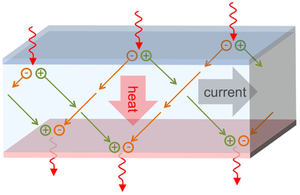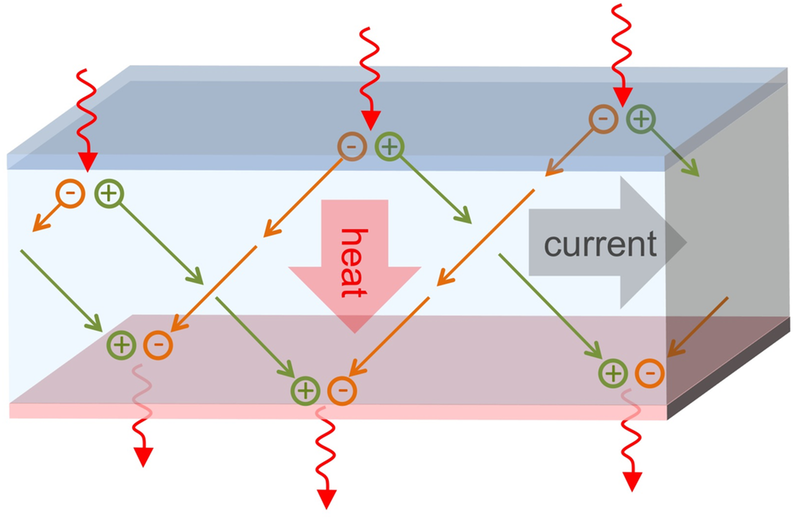A New Direction for Thermoelectric Cooling
Solid-state cooling devices exploit the thermoelectric effect, in which electric current induces heat flow in the same or opposite direction as the current. In Physical Review Letters, researchers propose that materials in which positive and negative charges move at an angle to each other can transport heat perpendicular to the current. If they prove practical, such materials could lead to compact new designs and to devices that cool electronics to lower temperatures than is currently possible.
The thermoelectric effect in metals arises because the electrons that carry charge also transport heat. The situation is more interesting in semiconductors, where electrons populate distinct ranges of energy levels called bands. Holes, where electrons are missing from otherwise-filled bands, act as positive charges that carry energy in the opposite direction from the current-carrying electrons. (These electrons are in different bands from the holes.) Normally, the heat transported by electrons and holes partially cancels out.
The situation changes dramatically when electrons and holes don’t move in exactly opposite directions, say Matthew Grayson of Northwestern University in Evanston, Illinois, and his colleagues. They analyze the case where an electric current along one axis of a crystal is carried mostly by electrons, whereas current in the perpendicular directions consists mostly of holes. When the current runs at an intermediate angle, they find a “transverse” thermoelectric effect that moves heat perpendicular to this current.
Such anisotropic conduction is not common, but it could be achieved, for example, in artificial “heterostructures” consisting of alternating ultrathin layers of indium arsenide and gallium antimonide with atomically precise thicknesses, Grayson says. If the layers are thin enough, electrons will penetrate them readily, while holes—which reside in a band with different properties—will be blocked and thus move only within the layers.
A thin film of such a material on a horizontal substrate surface, oriented so that the layers angle down into the substrate, would exhibit the transverse thermoelectric effect. A horizontal electric field, crossing the layers, would push holes downward along the layers toward the substrate, and the holes would carry energy with them. The negative electrons would dominate the current perpendicular to the layers, but this current would also flow downward toward the substrate. Both electrons and holes would therefore move heat away from the top of the film, cooling it and anything that sits on it.
The charge and heat move in perpendicular directions, so the area available for vertical heat transport can be much larger than if it were confined to the same cross-section as the current, as in traditional thermoelectric devices. “That’s the essence of why you can make these structures [work],” Grayson says, and they should work well even when the material carries much less heat, relative to the electric current, than a traditional thermoelectric material does.
Device structures that exploit anisotropic materials were extensively analyzed years ago. At the time, however, most researchers imagined creating the transverse effect with a high magnetic field of around tesla, which is not practical for most real-world situations. The newly proposed materials should be able to adopt some of the old design ideas, says Grayson, which could allow them to generate larger temperature differences than current techniques. He says that current solid-state refrigeration systems have trouble cooling room-temperature devices below about kelvin. Since the effect requires only a single material, it could also lead to compact coolers for nanotechnology devices.
Grayson admits that the heterostructure-based devices would be difficult to make, in part because such materials are normally grown with the layers parallel to the substrate. But he says that natural materials including cesium bismuth telluride and rhenium silicide show related effects and might be more practical. Alternatively, the phenomenon might be easier to exploit in novel, nonplanar devices, he says. “This technology is going to spawn new geometries.”
“This presents a really new twist, from a material and device perspective,” says Gang Chen of the Massachusetts Institute of Technology (MIT) in Cambridge. But he cautions that the results still need to be checked with experiments to be sure that real structures can fully exploit the effect.
–Don Monroe
Don Monroe is a freelance science writer in Murray Hill, New Jersey.





